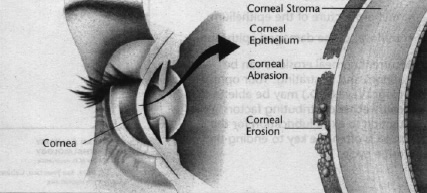Educational Materials: CORNEAL ABRASIONS & EROSIONS
 WHAT IS THE CORNEA?
WHAT IS THE CORNEA?
The cornea is the clear front window of the eye. It covers the colored portion of the eye, much like a watch crystal covers the face of a watch. The cornea is com-posed of five layers. The outermost layer is called the epithelium.
WHAT IS A CORNEAL ABRASION?
A corneal abrasion is an injury to the epithelium. Abrasions are painful. Common causes of corneal abrasions include problems from contact lenses, finger-nails, paper cuts, tree or bush limbs or rubbing of the eye. There are some eye conditions, such as dry eye, that may make injury more likely. The corneal surface usually heals within a day or two, but the eye may be very uncomfortable while it is healing. Tearing, light sensitivity and the feeling that something is in the eye-“foreign body sensation”-will accompany even a small abrasion.
HOW ARE ABRASIONS TREATED?
A common treatment is to patch the scratched eye, thus preventing the blinking eyelid from moving over the healing area. Another common treatment is repeated application of ointment to the eye, which forms a soothing layer between the inner eye lid and the abrasion. Antibiotics are often used because of the small risk of infection. Sometimes a drop is used to dilate the pupil to help with pain associated with light sensitivity. Even after the surface has healed, the cornea may still be sensitive to wind and dust. Often, additional lubrication is helpful, both during the day and at bedtime, until the sensitivity has disappeared. Some other diseases, such as dry eye or diabetes, may slow healing.
WHAT IS A CORNEAL EROSION?
A corneal erosion is a spontaneous breakdown of the epithelium, sometimes at the site of an earlier abrasion. The symptoms are similar to a corneal abrasion: foreign body sensation, tearing and light sensitivity. These symptoms may vary, are often unpredictable and may occur upon awakening. An erosion may occur when the eyes are dry or irritated.
